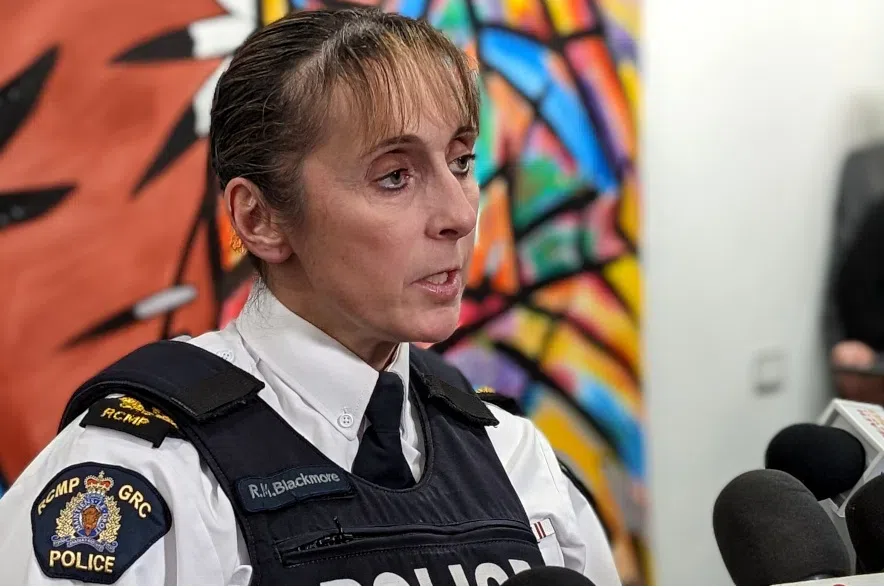About three months after a pair of inquests into the 2022 stabbing attacks on the James Smith Cree Nation and in Weldon, the Saskatchewan RCMP is responding to recommendations made by the juries and presiding coroners.
There were 14 recommendations altogether after the inquest into the 11 killings Myles Sanderson perpetrated on the James Smith Cree Nation and in Weldon, though some overlapped with each other. Eleven recommendations were directed at RCMP by the jury and presiding coroner Blaine Beaven, with the goal of preventing similar deaths in the future.
In the second inquest, which looked into the circumstances surrounding the in-custody death of Sanderson, three recommendations were made to the RCMP by the jury.
Assistant commissioner Rhonda Blackmore, commanding officer of the Saskatchewan RCMP, said the police force would take a look at the recommendations and see if they could be implemented.
At the end of May, Blackmore sent the RCMP’s response to the province’s chief coroner. In many cases, the RCMP agreed with the recommendations and was already working toward implementing them.
One recommendation was to prominently date photos of suspects, as an RCMP officer had spoken with Damien Sanderson, Myles’ brother, just ahead of the killings, but the photo of Damien the officer saw was several years old and badly out of date.
The RCMP said in its response that it agreed with the recommendation and was working on processes around photos. In the future, the Mounties said photos will include an identifying occurrence number, the detachment responsible for getting the photo and the date the picture was obtained. It’s also working on different ways to view and utilize photos, including in a new mobile app.
The RCMP said it is also working on a recommendation to provide a list and details of the 60 highest-priority targets of its Warrant Enforcement Suppression Team to detachment commanders on a regular basis. The Mounties said the team now sends a list of the most violent offenders in a detachment area to each detachment commander.
The RCMP said it also already has processes and guidelines in place to let leaders of a First Nation know when a member is a most-wanted target – the leaders of the James Smith First Nation have said they should have been informed that Myles Sanderson was at large.
The RCMP said it was already meeting other recommendations.
Regarding a recommendation that police review the criteria for a high-speed pursuit, the RCMP said it has national policy that addresses this, and its operational manual got a complete re-write in 2020 and was further enhanced in 2023. The response said there’s no longer specific criteria for a high-speed pursuit, and instead the situation is continually evaluated.
Another recommendation called for the Mounties to add more training around enhanced extraction techniques for arrests, but the RCMP said officers already have the appropriate training. The response said any further work on the techniques would have to be developed at a national level.
Other responses got a little more complicated.
A number of the recommendations were around providing more resources to, and even expanding, the RCMP’s specialized response teams like the Warrant Enforcement Suppression Team, Crime Reduction Team and Saskatchewan Trafficking Response Team.
The RCMP said it agrees with those recommendations in principle, but said staffing is a challenge. Vacancies on the teams range between 20 and 40 per cent, and while the RCMP is working on staffing up and said recruitment projections over the next few years will help, funding for the teams is provided by the province and the RCMP won’t ask for more funding to expand while vacancies remain so high.
Another of the recommendations was to include repeat domestic violence offenders in the matrix used by the warrant team and rank those individuals higher. The RCMP again agreed with the recommendation in principle, but explained that it would have to be a manual addition to the system which would be complicated, take significant time, and has limitations.
In the meantime, the RCMP said it has a new template for the monthly most-wanted list which adds a flag to those with a history of domestic violence – it doesn’t rank them higher, but does help officers decide which offenders to concentrate on.
The RCMP’s response amounted to a maybe on a recommendation that the RCMP include the PIT maneuver – the precision immobilization technique which was used to get Myles Sanderson’s truck off the road before he was arrested – in mandatory enhanced driver training.
The RCMP said the Advanced Emergency Vehicle Operators Course is going through a national update, and the police force will look at potentially including an optional module on the PIT maneuver.
Blackmore and other Saskatchewan RCMP leaders are expected to speak to media on Thursday morning to answer questions about the recommendations and the RCMP’s responses.
They’re also expected to publicly present an internal review the RCMP completed on its response to the mass stabbing.











